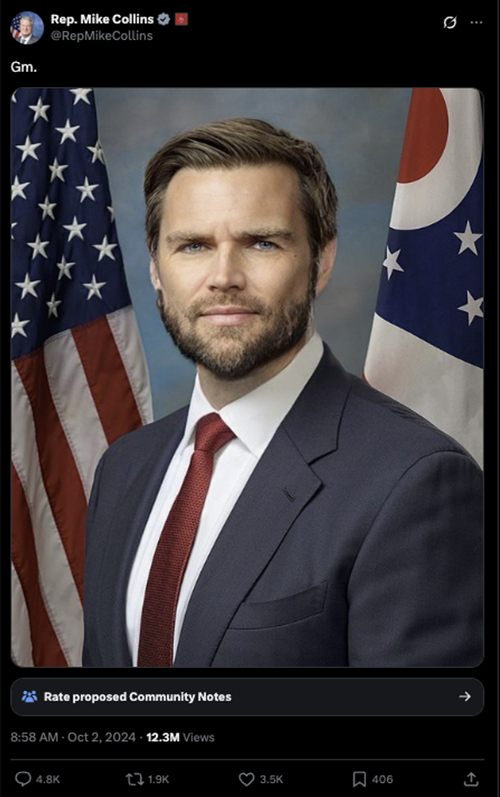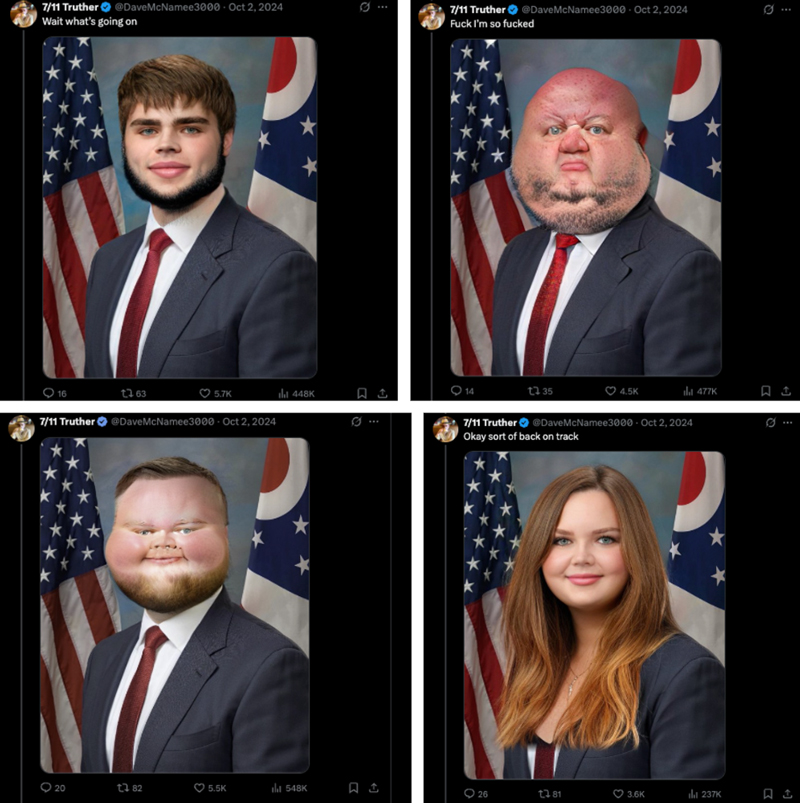Memes present us with the familiar tension between individual texts and the fluid generic categories that bind them together. What is the “meme” when I Rickroll a friend: is it the friend’s arrival at the YouTube video of Rick Astley shimmying in a church, or is it the recognizable practice of concealing this link and delivering the friend to the video unwittingly?
For rhetoric scholar Eric Jenkins (2014), it is the latter. Jenkins argues that a meme “is a mode—a shared, virtual orientation” toward objects that “circulate across media platforms, producing a recognizable structure” for actualizations in the form of individual texts (p. 443). This virtual structure, the meme as “mode,” is a processual, fluid, relational, and affective construct that imbues certain rhetorical performances with cultural resonance. For an individual meme-text to be recognized as a case of a particular meme, it must adhere to the meme’s “modal frame”; however, the collective production of actualizations can gradually remap the affective boundaries comprising the virtual structure.
This dynamic helps explain what is often articulated adjectivally about memes: they are playful. Memes engage in what Game Studies scholars call the ludic, a term that refers to a patterned mode of participation structured by constraint and possibility. Ludus is the “game” that provides coherence to unstructured “play” (paidia), disciplining it by imposing a set of rules, a social logic, and a stabilizing signification (Caillois, 2001, p. 13; Jensen, 2013, p. 69). Rhetorical invention in the context of memetic circulation is certainly playful; however, as Jenkins notes, it is not without discipline. Rather it is a kind of ludic rhetoric: when we make a meme, we are “playing within [a]mode to produce actualizations of [its]virtual structure” (p. 447).
This ludic dimension is central to understanding memes as rhetorical forms. Memes are not just texts we produce and circulate, but games we play. As Aaron Trammell (2023) points out, this “mangle of play is inscrutably affective” (p. 47). Trammell’s work enables us to see how memes, as games, are not only disciplined but acts of disciplining. His recent work calls for an expanded theorization of the ludic that encompasses a range of affects beyond pleasure and “allows us to better locate play on the margins, in the in-between”—in short, how playing games can also be productive of power relations (2023, p. 43).
Drawing on Sara Ahmed’s (2004) examination of how affective economies “align individuals with communities … through the very intensity of their attachments” (p. 119), I posit that this social edge of affect keys us into the rhetorical function of memes as digital “play modes” (Petersen, 2022, p. 51). Memes, as sites of “playing together” according to socially located affective and ideological virtual structures of potentiality, function as rhetorical performances that can consolidate in-group identity and “push away outsiders” while simultaneously (re-)constructing and marking “outsider” identities (Phillips & Milner, 2017, p. 112). The rest of this blog post advances an analysis of the ludic rhetoric of the J.D. Vance Photoshop meme that emphasizes how the meme works to enforce and propagate white supremacist and heteropatriarchal modes of discourse as it circulates through digital platforms.
As noted on Know Your Meme, the J.D. Vance Photoshop meme revolves around distorted images or GIFs of Vance’s face (2024). The alterations range in valence and degree, from puffing out Vance’s cheeks and splicing in a propeller beanie and lollipop to remixing Vance’s face with artist John D Salvatore’s rendering of Blood Meridian’s Judge Holden. On October 2nd, 2024, the day after the Vice Presidential Debate, Georgia Republican Congressman @RepMikeCollins tweeted a version of Vance’s Senate portrait wherein Vance’s cheeks and jawline are sharpened, his eyebrows are darkened, and his hair is made to appear fuller (Figure 1).

On the same day, Twitter user @DaveMcNamee3000 began a thread that played with the concept of digitally altering the photo. Instead of editing the image to bring Vance’s visage in line with an idealized white masculinity, the thread progressively distanced Vance from that ideal by first infantilizing him (engorging and reddening his cheeks) and then spiraling into an absurdist succession of images. Vance is aged up and bald; depicted with an apparently dyed beard, lipstick, and Bieber cut; and finally, represented as a woman (Figure 2).

From the meme’s origins, the logics of its participatory elaboration were clear—as long as you post an image of Vance that is simultaneously obviously not Vance, you have collaborated in the rhetorical circuit of “the JD Vance meme.” Its modal frame orients the memetic prosumer to reify an idealized white masculine subject as the center of gravity, iteratively playing upon the distance, degree, and direction of difference constructed through the presentation of a series of not-Vance images held against the true Vance. Here, even rhetorically antagonistic Vance memes that disidentify Vance with this idealized subject accept and privilege this subject as a metric against which bodies are judged and belonging is constructed.
The meme’s idealized subject is stabilized through its relation not to J.D. Vance or even Tim Walz, the other 2024 V.P. candidate, but to former Vice President Kamala Harris. The prior summer’s “Kamala is brat” meme, for all its optimistic force and genuinely felt potentialities, worked to read Harris as deviating from the normative (old, white, straight, male) American political subject signified by Joe Biden (Cerja et al., 2024, p. 90). The Vance meme, against this context, functions as a white supremacist rhetorical tool “for assessing and administering …gendered racial fitness for nation building, citizenship,” and in a very concrete sense, for being the Vice President (Rodríguez, 2021, p. 105).
Part of why I find the ludic useful in thinking through the rhetorical circulation of memes is the framework’s capacity for attending to the implications of each act of play. Each actualization of a meme’s modal frame reproduces its “play rules,” and the more these memes travel, “the more they circulate, the more affective they become” (Ahmed, 2004, p. 120). As the Vance meme has gained traction through early 2025, its play rules have only become more entrenched and reified as a result of its circulation. One question I am left with, then, is how we might envision ludic rhetorics leveraged for liberatory cultural and political projects. I’m not quite sure, but I feel strongly that we ought to bring the concept into play.
References:
7/11 Truther [@DaveMcNamee3000]. (2024, October 2). For every 100 likes I will turn JD Vance into a progressively apple cheeked baby https://t.co/WgGS9IhAfY [Tweet]. Twitter. https://x.com/DaveMcNamee3000/status/1841505527664124409
Ahmed, S. (2004). Affective Economies. Social Text, 22(2), 117–139.
Callois, R. (2001). Man, Play, and Games. University of Illinois Press.
Cerja (she/her), C., Nave (she/her),Nicole D., Winfrey (she/her),Kelly L., Helen Palczewski (she/her),Catherine, & and Hahner (she/her), L. A. (2024). Misogynoir and the public woman: Analog and digital sexualization of women in public from the Civil War to the era of Kamala Harris. Quarterly Journal of Speech, 110(1), 74–100. https://doi.org/10.1080/00335630.2023.2192262
Dark,Odd,Conspiracy [@DarkOddCon]. (2025, March 18). Https://t.co/rutoDZt2AO [Tweet]. Twitter. https://x.com/DarkOddCon/status/1902139693635879030
J.D. Vance Edited Face Photoshops. (2024, October 3). Know Your Meme. https://knowyourmeme.com/memes/jd-vance-edited-face-photoshops
Jenkins, E. S. (2014). The Modes of Visual Rhetoric: Circulating Memes as Expressions. Quarterly Journal of Speech, 100(4), 442–466. https://doi.org/10.1080/00335630.2014.989258
New Liberals 🌐🇺🇦 [@CNLiberalism]. (2025, March 1). “Have you said thank you once” https://t.co/01mm34xg1u [Tweet]. Twitter. https://x.com/CNLiberalism/status/1895672882627559829
Petersen, L. N. (2022). Mediatized fan play: Moods, modes and dark play in networked communities. Routledge.
Phillips, W., & Milner, R. M. (2017). The ambivalent Internet: Mischief, oddity, and antagonism online. Polity.
Rep. Mike Collins [@RepMikeCollins]. (2024, October 2). Gm. Https://t.co/Koe8f0uhnF [Tweet]. Twitter. https://x.com/RepMikeCollins/status/1841462716348678274
Rodríguez, D. (2021). White reconstruction: Domestic warfare and the logics of genocide (First edition). Fordham University Press.
Trammell, A. (2023). Repairing play: A Black phenomenology. The MIT Press.
